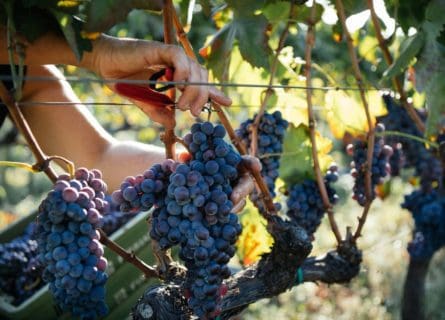
Nero d’Avola Grape Variety: The Spice of Sicily
August 14, 2021
Explore Nero d'Avola: Sicily's prized red grape, introduced by the Greeks, known for its rich, dark wines, and esteemed for its versatility.
Estimated reading time: 1 minute
Italy wrote the book on viticultural diversity. A nation of just over 59 million people boasts a treasure trove of indigenous grape varieties and esoteric wine styles that have no equal anywhere in the world. If you care to look, untold riches await discovery in this complex, incredibly diverse country.
The catalyst for this unprecedented creativity and dynamism originates in the ancient world. Although the Etruscans controlled the center of the Italian peninsula in the 8th century BC, Greek traders and colonists began gaining a foothold in southern Italy. They founded a series of independent city-states along the coast and in Sicily, known as the kingdom of Magna Graecia. Their arrival heralded a turning point in Italian viticulture, as the Greeks brought all manner of grape varieties with them. Indeed, the colonists once called Italy ‘oenotria’ or the land of wine. Subsequent visitors to mainland Italy and its islands, including the Visigoths and Aragonese, have left an indelible mark on the nation’s vinous identity.
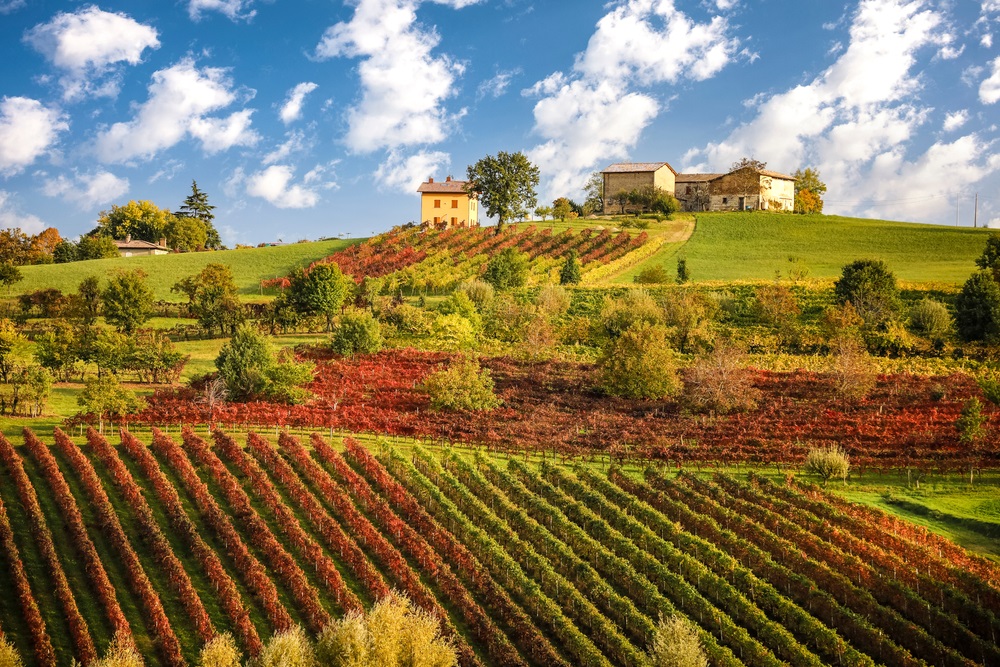
Ultimately, Italy’s unbelievably varied topography is responsible for the wine paradise we enjoy today. Every Italian region is in the wine business, offering distinct traditions, terroirs, and climatic variances. In addition, there are endless opportunities to grow almost every grape variety known to man due to the mosaic of soil types, vineyard elevations, micro-climates, and aspects. As a result, generalizations about Italian wine are impossible.
Yet, the forces of globalization and standardization are present in Italian vineyards. Cabernet Sauvignon arrived as far back as the early 1800s. By the 20th century, many regions relied on the easy money made from ubiquitous wine styles like varietal Merlot and Sauvignon Blanc. The Super Tuscan revolution of the 1960s and 70s has undeniably produced a surfeit of exceptional wines, often based on the classic Bordeaux blends.
However, the 21st century has seen Italy return to its roots. A global market increasingly saturated with international varietals is no longer the commercial nirvana for Italian growers. As a result, the reverence for Chardonnay and Syrah is fading quickly as consumers seek out points of difference and authenticity in their wine choices. Of course, Italy will always have international wine styles – the best examples are great wines. But they can never compete with the excitement of exploring the road less traveled; Fiano, Greco, Negroamaro, Nerello Mascalese, Teroldego, and Lagrein are all waiting to be discovered. After a slow start, Italy is waking up to absolute and undeniable truth; its future success depends on embracing its past.
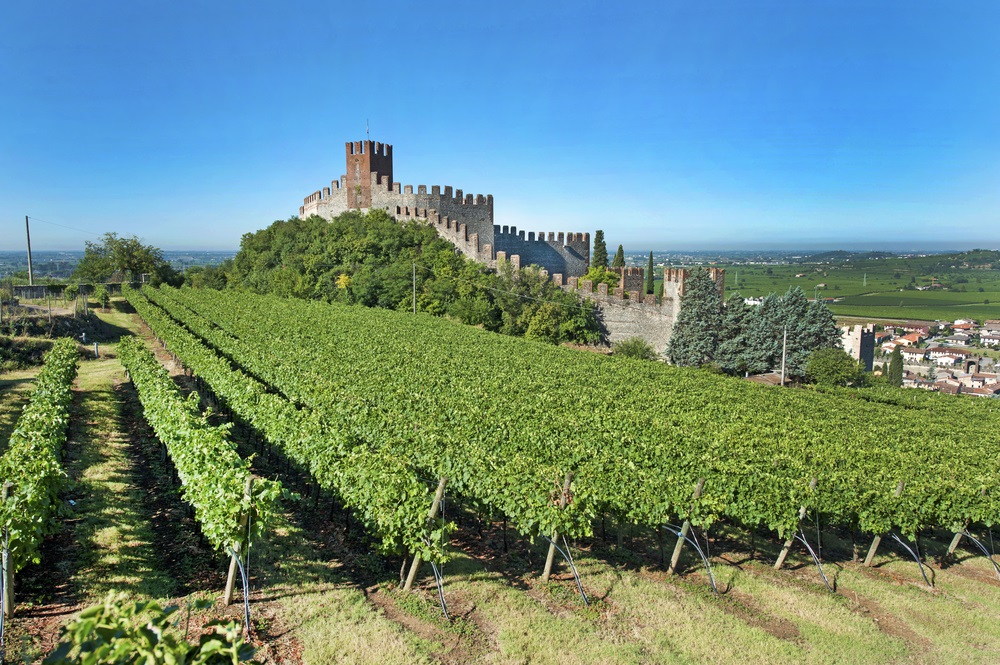
If Tuscany represents the true soul of Italian wine, then the vineyards of northeastern Italy run a close second. Nevertheless, this eclectic and spectacular mountainous region is responsible for a sparkling wine icon: Prosecco. Made across nine provinces in the wider region, Prosecco has remained astonishingly popular, not least because it is both affordable and delicious.
Indeed, this corner of Italy offers a wealth of excellent sparkling wines. The Trentino-Alto Adige region is home to several thriving appellations, including TrentoDoc. Ferrari (no relation to the car) is the market leader, producing a range of excellent traditional method wines from Pinot Noir (and Chardonnay) grapes cultivated on steep valley slopes. Situated close to the Austrian border, Trentino-Alto Adige offers a wealth of local curiosities. Teroldego Rotaliano and Lagrein are authentic originals – two red grapes seldom seen outside northern Italy. Meanwhile, some love the sparkling red Lambrusco made in Emilia-Romagna, while others detest it. Croatina is another obscure gem of the region, also found in Lombardy.
More treasures are to be discovered in the Veneto province. The hills of Verona encompass a broad palate of wine styles, including the much-loved Valpolicella. Amarone della Valpolicella is magnificent – a potent and concentrated red wine with no parallel. By comparison, Italy’s far northeastern corner dedicates itself to producing white wine. Friuli-Venezia borders Slovenia and has been a powerhouse of Italian Pinot Grigio and Sauvignon Blanc for decades. Nevertheless, the appellations of Colli Orientali and Carso produce some exciting reds, the latter based on the (generally) unknown Refosco grape variety. The smaller Collio DOC appellation, situated south of Orientali, is also gaining a reputation for its fresh and fruity red wines.
Some have described Croatina as “the Syrah of Italy.” It is a late-ripening and high-yielding variety that requires judicious pruning throughout the season to control its growth. However, it can produce fragrant and elegant red wine in the right terroirs (such as ‘DOC Oltrepò Pavese Bonarda’ in Lombardy). It is often blended with Barbera.
A rarity in the world of wine, winemakers in parts of Emilia Romagna produce the red Lambrusco grape in a ‘frizzante’ style. They must check its natural vigor, or it tends to produce high yields.
A wonder of the Trentino region, Teroldego is a late-ripening variety that produces intensely pigmented red wines that require a dry growing season.
A specialty of Alto Adige, Lagrein produces floral and tannic wines with beautiful aromatics.
A late-ripening variety, Corvina is the dominant grape in most Valpolicella wines. People much love it for its signature sour cherry, damson, and raspberry flavors.
Seldom enjoyed outside of its homeland, the term Refosco refers to a family of closely related red grape varieties. It is mainly found in Slovenia and neighboring Friuli-Venezia.
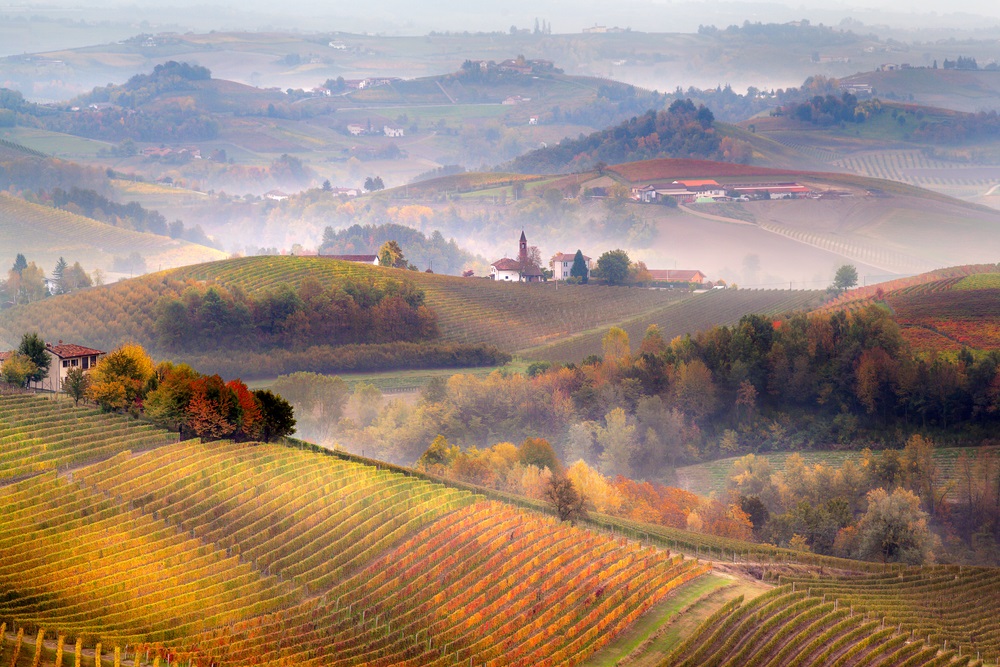
For many wine lovers, northwest Italy begins and ends with Nebbiolo. The signature red grape of Barolo and Barbaresco is arguably responsible for Italy’s greatest red wine style – a rival to Grand Cru Burgundy. Yet other wonders are discovered in the region, including Barbera, Dolcetto, and Rossese. Italy’s smallest wine region, Valle d’Aosta, grows Nebbiolo on steep Alpine hills, producing fine and elegant wines with bags of acidity. Its indigenous varietal is the little-known Petit Rouge, a dark-skinned variety that yields aromatic and floral wines. The Fumin grape is another local curiosity.
But it is the vineyards located southeast of Turin that really excite the critics. Situated on the Right Bank of the River Tanaro, the wines of Barolo and Barbaresco continue to fetch a handsome price. However, ‘lesser’ appellations throughout the Piedmont wine region now craft excellent Nebbiolo wines at very fair prices. The hills of the Roero appellation, on the opposite side of the river to Barolo, have proven to be an excellent terroir for the Nebbiolo grape. The zone of Monferrato situated further north is another excellent source of affordable ‘Barolo imitations.’
Next in line to the throne is Barbera, Piedmont’s second red grape variety. It comes in many guises: light, fruity, unoaked, and lavishly seasoned in French barrique. Although many consumers gravitate towards more delicate and softly structured Barbera wines, the latter is often robust and concentrated.
It has two heartlands: the communes of Alba and Asti. Further sub-zones exist in the Barbera d’Asti and Alba appellations, including Tinella and Astiano. The zone of Nizza was elevated to DOCG status in 2014. It is probably the finest source of Barbera wines made in Italy today.
Dolcetto must not be excluded from this list. It produces the most delectable red wines: soft, fresh, and fruit-driven. It dominates vineyards cultivated in Alba’s hills, where it will reliably ripen even at high altitudes. Relatively low in alcohol and very food-friendly, Dolcetto is a wine style for the emerging age of moderation and restraint. Grignolino is a very esoteric red grape native to Piedmont. Only small quantities are made and rarely exported. Light and low in tannin, it is a wine style for early consumption.
Barbera is an early-ripening red variety that must be grown on warm soils with a south-facing aspect. At its best, the grape produces soft and velvety wines with red berries and cinnamon aromas. A judiciously oaked example offers more structure and depth.
Due to its moderate alcohol and soft tannins, Dolcetto is increasingly finding a fan base abroad. It prefers calcareous and sandy soils and will ripen in cooler climates. Unfortunately, it can nearly always be drunk at a young age.
It takes an experienced professional to master this notoriously capricious grape variety. Capable of producing exquisite red wines or astringent dross, Nebbiolo needs warm conditions and well-drained calcareous soils. It ripens late in the season and must be handled carefully in the winery. The top wines will age for decades after release.
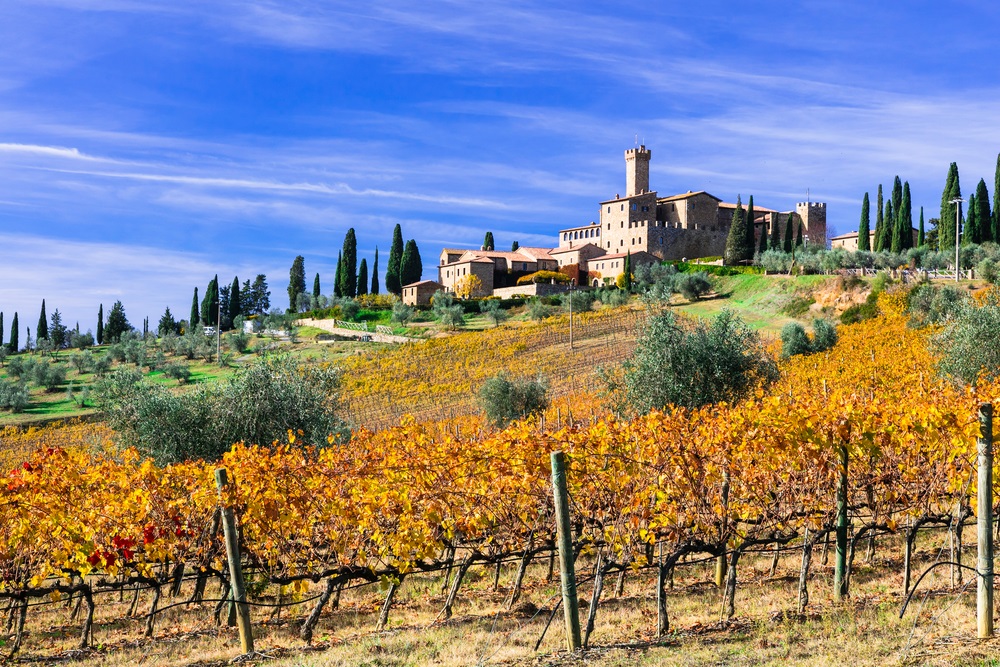
Seasoned travelers often insist that central Italy is the most beautiful place in the world. They may have a point; the rolling pastoral landscape that defines Tuscany’s Chianti Classico and Montalcino regions are breathtaking, a bucolic idyll defined by vines, cypress trees, and endless olive groves. It is the most instagrammable place in Europe before we even start discussing excellent wine and gastronomy.
Above all, central Italy is a complex and paradoxical wine destination, with endless variances in soil, elevation, and winemaking philosophy. On the one hand, the Maremma region of coastal Tuscany is defined by its love of international varietals – it is the birthplace of Sassicaia, founded by the Marchese Incisa della Rochetta in the 1940s. On the other hand, the site he chose for his inaugural wine project now has its own appellation: Bolgheri. Further south, the Maremma zone is full of Bordeaux blends, with a particular nod to Cabernet Franc. The best of this firmament is admittedly world-class.
However, oenophiles usually gravitate towards the original flavors of central Italy. Montepulciano is cultivated on the Adriatic coast in the appellation of Montepulciano d’Abruzzo. As a result, the best wines are very reminiscent of Merlot, with their aromas of red berries and eucalyptus. Moreover, the variety’s usually moderate tannin levels make it an accessible choice for impatient wine lovers.
The same cannot be said for Sangiovese, the signature red grape of Chianti Classico and Brunello di Montalcino. The hills between Florence and Siena have been cultivating Sangiovese for many centuries. The Chianti zone was the first in the world to be delimited in the 1600s. Historically, the now subordinate Caniaolo grape was the mainstay of Chianti blends, a state of affairs that endured until the 19th century. Today, some growers blend Merlot and/or Cabernet Sauvignon into their wines. However, a growing movement is to make 100% Sangiovese wines a legal requirement for the top-tier Gran Selezione and Riserva categories. The local Colorino is also occasionally added. Contemporary Chianti Classico is fastidiously made and designed to be aged for many years after release.
Brunello di Montalcino has long been a favorite of US collectors. Regulations permit only 100% Sangiovese wines – rich and powerful vinous icons that owe their weight and structure to the hotter climate of Montalcino, located south of Siena. Its neighbor to the east, Montepulciano (not to be confused with the appellation in Abruzzo), again produces Sangiovese-dominant wines in a warm climate. In Umbria, winemakers also produce some excellent wines, most notably the ‘Super Umbrians’ of Torgiano.
Once prolific in central Tuscany, Canaiolo has recently made a modest comeback. The biggest challenge is that it tends to give inflated yields unless growers curtail its natural vigor throughout the growing season. However, the thin-skinned Canaiolo can yield fragrant and tasty wine with red berry aromas and medium tannins.
Renowned for its high level of coloring pigments, winemakers only occasionally add Colorino to modern Chianti blends. However, some growers appreciate the tannic structure and acidity that the grape can bring to the final product due to Colorino’s thick skins packed with phenolic compounds.
Montepulciano is perhaps the most underrated of central Italy’s viticultural assets. It is a late-ripening and deep-colored grape. But, confusingly, it is also the name of an unrelated famous town in Tuscany.
It competes with Nebbiolo for the title of ‘Italy’s most globally recognized grape variety.’ The principal red grape of west-central Italy has a reputation for being difficult to grow successfully, yet it can offer rich rewards if handled with care and attention. It produces sublime and structured red wine in the hills of Chianti Classico and Montalcino, where it receives the necessary heat and sunlight to ripen its hefty tannins.
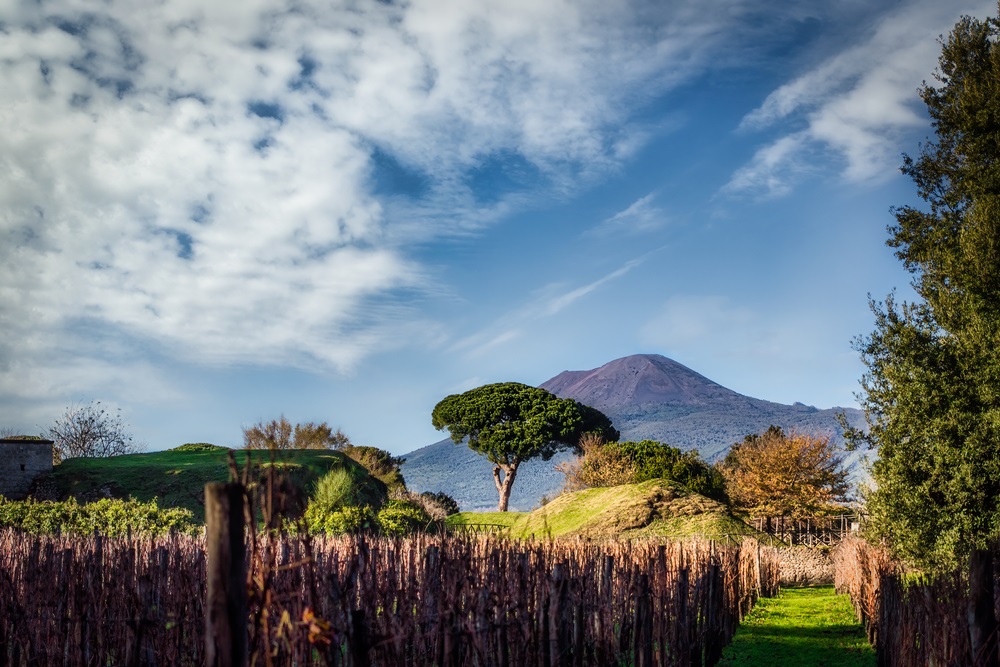
Known as il Mezzogiorno (land of the midday sun), southern Italy has recently undergone a radical image change. Growers and winemakers who care have replaced industrial volumes and lackluster quality with a growing collection of premium wines. Moreover, as competition from the New World erodes the market for cheap European wine, local winegrowers are continually upping their game. The result is an area brimming with innovation and excitement, mainly focusing on indigenous varieties.
The pleasure starts in Campania, home of the tannic and brooding Aglianico grape. However, the finest expressions are in the Taurasi DOCG zone, located east of Naples. Old Aglianico vines grown on the volcanic hills of Taurasi produce racy and potent wine, described as the “Barolo of the south.” Its closest rival is the appellation Aglianico del Vulture in the more southerly province of Basilicata. Growers cultivate the grape on the higher slopes of an extinct volcano, which moderates the balmy summer heat and maintains freshness in the wines. You can also find the grape on the Adriatic coast in the small region of Molise.
Indeed, southern Italy has the richest source of esoteric grape varieties and wine styles in Europe. Lacryma Christi reds grown on the slopes of Mount Vesuvio can be delicious, as can the red varieties of the little-known Caserta province north of Naples. Under the IGT Terre del Volturno, growers make small volumes of the red Casavecchia, a grape seldom seen outside the zone. Further south in Calabria, you’ll discover Ciro, a red wine based on the Gaglioppo grape. The wines are often delicate and aromatically expressive, with an enticing bouquet of cherries and oriental spices.
The ‘heel of the Italian boot’ has more surprises. In the Puglia region, the wine scene has undergone a similar transformation, with a renewed emphasis on protecting its low-yielding bush vines and their remarkable concentrated berries. The area’s most important appellation is the Primitivo di Manduria DOC, home to the Primitivo or Zinfandel grape. As a result, the best wines are voluptuous, powerful, and yet refined, with a pungency unequaled anywhere in Italy. Growers are also achieving great things in the flat Salento peninsula, exploiting the cooler micro-climates that are a concomitant feature of the strong Adriatic sea breezes.
Negroamaro is another variety worthy of closer scrutiny. Although the name means “black of bitter,” the grape can produce elegant and balanced wine in the right hands. The vines suit the arid climate down to the ground; Negroamaro vines are very robust and hardy, capable of surviving for prolonged periods without water. It thrives in the appellations of Salice Salentino and Nardo, especially when planted on calcareous soils. In addition, the cooling breezes from the Gulf of Taranto help keep the alcohol levels in check.
The star variety of southern Italy is becoming more fashionable with each passing year. It has no shortage of phenolic compounds or extracts; poor examples can be fiercely tannic and austere. But at its best, Aglianico is incomparable, dark, deep, and brooding.
‘Black of bitter’ needs the right soils and climate to succeed. Its natural vigor must constantly be checked to ensure quality emerges after the harvest. It has the potential for both high quality and high volume.
Known as Zinfandel in the US, the early-ripening Primitivo was originally from Croatia. In the right hands, it can make sophisticated and potent wine. Unfortunately, however, many fiercely alcoholic and unbalanced bottles are still around.
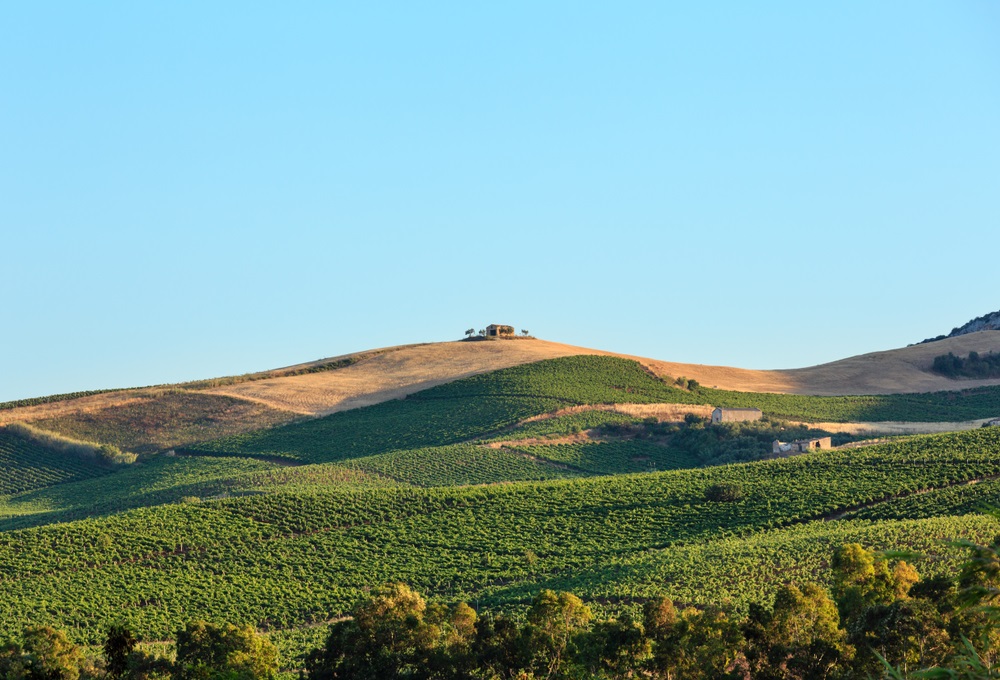
It would take a lifetime to get to grips with the viticultural treasures of Sicily and Sardinia. They are as rich in indigenous varieties as in culture and history; the Greeks, Romans, and Moors have controlled Sicily over the centuries. The north-western tip of Sicily is closer to Africa than Europe, ensuring that irrigation is required for a great deal of the island’s arid landscape. However, the island’s varied topography helps moderate the heat in certain places, particularly on the dramatic slopes of Mount Etna.
This is frontier winemaking at its most authentic – who else in Europe could claim to grow vines on an active volcano? As a result, investors have flocked to the vineyards of Etna, keen to harness the potential of several indigenous varieties and an impressive range of elevations, exposures, and soil types. The two superstar grapes of Etna are Nerello Mascalese and Nerello Cappuccio, often blended under the Etna Rosso appellation. Under the auspices of the Faro DOC in the island’s northeastern corner, producers combine them with another Sicilian red grape called Nocera.
However, the indigenous grape that made Sicily’s reputation abroad is undoubtedly Nero d’Avola. Grown in the appellations of Eloro and Noto in south-eastern Sicily, it makes structured and age-worthy wine. Calcareous soils suit it best, as high elevations moderate the evening heat. Nero d’Avola does not need any help to produce excellent wine, although winemakers blend it with the local Frappato in the Cerasuolo di Vittoria DOCG in southern Sicily. Frappato is a wonderful variety, yielding wines of inimitable freshness and style. Its acidity and bright red fruit profile are a welcome foil to Nero d’Avola’s power and concentration.
Sardinia, meanwhile, has admittedly been slower in attracting international attention and investment to its wines. Nevertheless, some remarkable discoveries can be made here; the kingdom of Aragon ruled the island for four centuries, endowing it with some of Spain’s key grape varieties. Under the local synonym Cannonau, Grenache produces some beautiful wines in the appellation of Cannonau di Sardegna DOC. Winemakers produce the best wines inland, with some exciting developments happening in the village of Mamoiada. In Sardinia, growers also cultivate Rioja’s Graciano and Mazuelo, known locally as Bovale Sardo and Bovale Grande. The widely planted Monica grape makes fruity and pleasant reds, albeit rarely exceptional. The almost unheard-of Giro grape is another curiosity.
Carignano del Sulcis, located in the southwest of the island, is probably Sardinia’s most promising appellation at present. The legendary Tuscan oenologist Giacomo Tachis was drawn to the area, his attention captured by Carignan’s ungrafted old bush vines. When blended with Grenache and Graciano, the wines are reminiscent of Priorat – spicy, full-bodied, and unbelievably concentrated.
Thin-skinned and challenging to grow, Frappato requires plenty of patience from the grower. But those who succeed will be rewarded with an aromatic, elegant red wine. Its first preference is planted on sandy/calcareous soils with good drainage.
Sicily’s most exciting red grape variety has enraptured critics – and winemakers. It is a medium-colored and characterful variety with singular aromas of cinnamon, garrigue, and sour cherry. When planted on volcanic soils, Nerello Mascalese transmits a sense of place with razor-sharp precision.
An obvious partner to the tannic charms of Nerello Mascalese, Cappuccio tends to make lighter and softer wine. It thrives on the volcanic slopes of Mt.Etna.
Tough and resourceful, Nero d’Avola is not particularly difficult to cultivate. It copes with the intense heat of the Sicilian summer with relative ease, producing Syrah-like red wines of potency and finesse. Top wines combine black fruit aromas with a spicy and full-bodied palate, driven by tertiary flavors of fennel, tobacco, and cedarwood.
If you would like us to customize an exclusive luxury tour, contact us and let us know your travel plans. We offer luxury food and wine tours for private groups of a mininium two guests. In addition, all of our private, chauffeured tours are available year-round upon request.


Best Wine Brand in Indiasays:
January 13, 2022 at 11:37 am
That's an elaborated guide on Italian red wines and wineries. No doubt red wine is the delicious elixir made by fermenting dark-skinned grape juice.